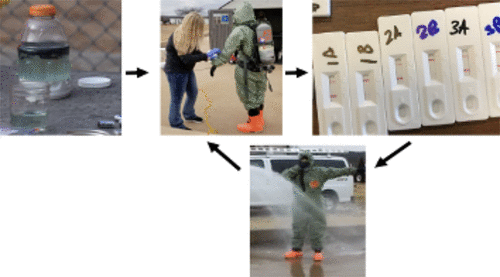当前位置:
X-MOL 学术
›
ACS Chem. Health Saf.
›
论文详情
Our official English website, www.x-mol.net, welcomes your
feedback! (Note: you will need to create a separate account there.)
Surface Contamination Generated by “One-Pot” Methamphetamine Production
ACS Chemical Health & Safety ( IF 2.9 ) Pub Date : 2020-12-16 , DOI: 10.1021/acs.chas.0c00078 Austin L. Ciesielski 1, 2 , Jarrad R. Wagner 1 , Marissa Alexander-Scott 2 , Jerome Smith 2 , John Snawder 2
ACS Chemical Health & Safety ( IF 2.9 ) Pub Date : 2020-12-16 , DOI: 10.1021/acs.chas.0c00078 Austin L. Ciesielski 1, 2 , Jarrad R. Wagner 1 , Marissa Alexander-Scott 2 , Jerome Smith 2 , John Snawder 2
Affiliation

|
Methamphetamine production is the most common form of illicit drug manufacture in the United States. The “one-pot” method is the most prevalent methamphetamine synthesis method and is a modified Birch reduction, reducing pseudoephedrine with lithium and ammonia gas generated in situ. This research examined the amount of methamphetamine surface contamination generated by one-pot syntheses or “cooks”, as well as the effectiveness of hosing with water as a simplified decontamination technique, to assess associated public health and environmental consequences. Concentrations of methamphetamine contamination were examined prior to production, after production, and after decontamination with water. Contamination was qualitatively field screened using lateral flow immunoassays and quantitatively assessed using a fluorescence covalent microbead immunosorbent assay. Following screening, 0 of 23 pre-cook samples, 29 of 41 post-cook samples, and 5 of 27 post-decontamination samples were positive. Quantitatively, one pre-cook sample had a methamphetamine concentration of 1.36 ng/100 cm2. Post-cook and post-decontamination samples had average methamphetamine concentrations of 26.50 ± 63.83 and 6.22 ± 12.17 ng/100 cm2, respectively. While all one-pot methamphetamine laboratories generate different amounts of waste, depending on the amount of precursors used and whether the reaction vessel remained uncompromised, this study examined the surface contamination generated by a popular one-pot method known to law enforcement. By understanding the amount of surface contamination generated by common methods of one-pot methamphetamine production and the effectiveness of decontamination techniques used to remediate them, health risks associated with these production sites can be better understood and environmental contamination can be mitigated.
中文翻译:

一锅法甲基苯丙胺生产所产生的表面污染
甲基苯丙胺生产是美国最常见的非法药物生产形式。“一锅法”是最流行的甲基苯丙胺合成方法,是经过改进的桦木还原法,可通过原位生成的锂和氨气还原伪麻黄碱。这项研究检查了由一锅合成器或“炊具”产生的甲基苯丙胺表面污染的量,以及用水作为简化的去污技术进行盛水的效果,以评估相关的公共卫生和环境后果。在生产之前,生产之后和用水净化后,都要检查甲基苯丙胺污染的浓度。使用侧向流免疫测定对污染进行定性筛选,并使用荧光共价微珠免疫吸附测定进行定量评估。筛选后,23个蒸煮前样品中的0个,41个蒸煮后样品中的29个,去污后27个样品中的5个为阳性。定量地,一个预烹饪样品的甲基苯丙胺浓度为1.36 ng / 100 cm 2。蒸煮后和去污后样品的平均甲基苯丙胺浓度分别为26.50±63.83和6.22±12.17 ng / 100 cm 2。尽管所有一锅法甲基苯丙胺实验室产生的废物量不同,但取决于所用前体的量以及反应容器是否完好无损,这项研究检查了执法人员已知的一种普遍使用的一锅法产生的表面污染。通过了解一锅法甲基苯丙胺生产的常见方法产生的表面污染量以及用于补救它们的去污技术的有效性,可以更好地了解与这些生产地点相关的健康风险,并可以减轻环境污染。
更新日期:2021-01-25
中文翻译:

一锅法甲基苯丙胺生产所产生的表面污染
甲基苯丙胺生产是美国最常见的非法药物生产形式。“一锅法”是最流行的甲基苯丙胺合成方法,是经过改进的桦木还原法,可通过原位生成的锂和氨气还原伪麻黄碱。这项研究检查了由一锅合成器或“炊具”产生的甲基苯丙胺表面污染的量,以及用水作为简化的去污技术进行盛水的效果,以评估相关的公共卫生和环境后果。在生产之前,生产之后和用水净化后,都要检查甲基苯丙胺污染的浓度。使用侧向流免疫测定对污染进行定性筛选,并使用荧光共价微珠免疫吸附测定进行定量评估。筛选后,23个蒸煮前样品中的0个,41个蒸煮后样品中的29个,去污后27个样品中的5个为阳性。定量地,一个预烹饪样品的甲基苯丙胺浓度为1.36 ng / 100 cm 2。蒸煮后和去污后样品的平均甲基苯丙胺浓度分别为26.50±63.83和6.22±12.17 ng / 100 cm 2。尽管所有一锅法甲基苯丙胺实验室产生的废物量不同,但取决于所用前体的量以及反应容器是否完好无损,这项研究检查了执法人员已知的一种普遍使用的一锅法产生的表面污染。通过了解一锅法甲基苯丙胺生产的常见方法产生的表面污染量以及用于补救它们的去污技术的有效性,可以更好地了解与这些生产地点相关的健康风险,并可以减轻环境污染。









































 京公网安备 11010802027423号
京公网安备 11010802027423号